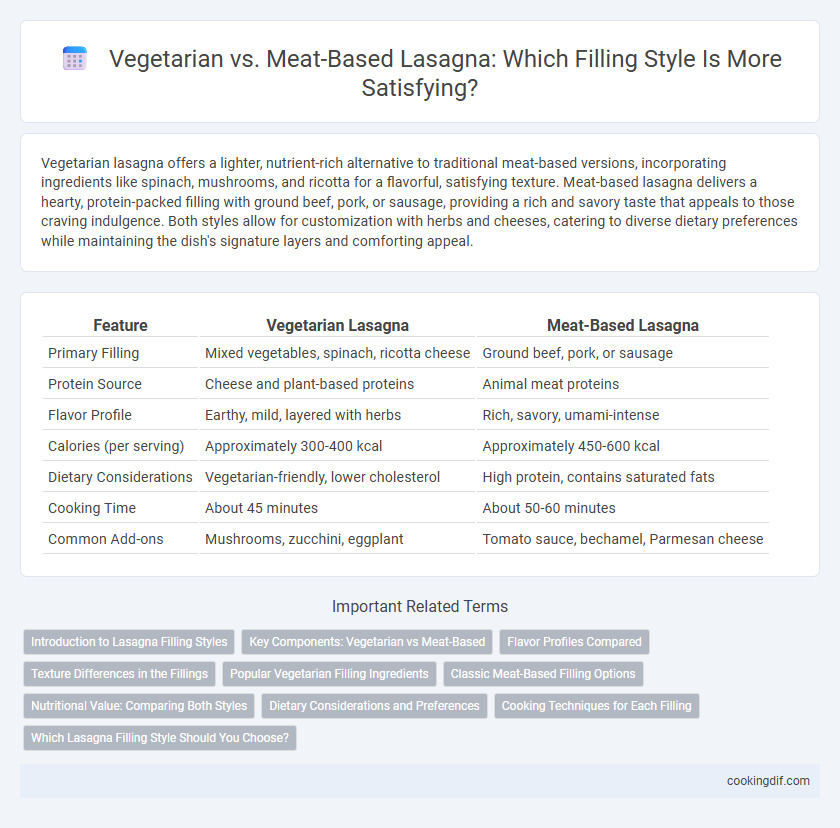Vegetarian lasagna offers a lighter, nutrient-rich alternative to traditional meat-based versions, incorporating ingredients like spinach, mushrooms, and ricotta for a flavorful, satisfying texture. Meat-based lasagna delivers a hearty, protein-packed filling with ground beef, pork, or sausage, providing a rich and savory taste that appeals to those craving indulgence. Both styles allow for customization with herbs and cheeses, catering to diverse dietary preferences while maintaining the dish's signature layers and comforting appeal.
Table of Comparison
| Feature | Vegetarian Lasagna | Meat-Based Lasagna |
|---|---|---|
| Primary Filling | Mixed vegetables, spinach, ricotta cheese | Ground beef, pork, or sausage |
| Protein Source | Cheese and plant-based proteins | Animal meat proteins |
| Flavor Profile | Earthy, mild, layered with herbs | Rich, savory, umami-intense |
| Calories (per serving) | Approximately 300-400 kcal | Approximately 450-600 kcal |
| Dietary Considerations | Vegetarian-friendly, lower cholesterol | High protein, contains saturated fats |
| Cooking Time | About 45 minutes | About 50-60 minutes |
| Common Add-ons | Mushrooms, zucchini, eggplant | Tomato sauce, bechamel, Parmesan cheese |
Introduction to Lasagna Filling Styles
Lasagna filling styles vary primarily between vegetarian and meat-based options, each offering distinct flavors and textures. Vegetarian fillings often include layers of roasted vegetables, ricotta, spinach, and rich tomato sauce, appealing to health-conscious and plant-based diners. Meat-based fillings typically combine ground beef, sausage, or veal with bechamel or tomato sauce, providing a hearty and traditional taste experience.
Key Components: Vegetarian vs Meat-Based
Vegetarian lasagna fillings often incorporate key components like spinach, mushrooms, ricotta, and zucchini, providing a nutrient-rich and flavorful alternative to traditional meat-based versions. Meat-based lasagna typically features ground beef or sausage combined with tomato sauce and a blend of cheeses, delivering a savory and protein-packed filling. Both styles balance layers of pasta sheets, bechamel or ricotta, and cheese to create distinct textures and hearty taste profiles.
Flavor Profiles Compared
Vegetarian lasagna fillings often feature robust flavors from roasted vegetables, fresh herbs like basil and oregano, and rich cheeses such as ricotta and mozzarella, creating a layered taste profile with earthy and creamy notes. Meat-based lasagna fillings typically emphasize savory, umami-rich flavors through seasoned ground beef or Italian sausage combined with tomato sauce and garlic, offering a hearty and intense palate. Both styles balance acidity and richness, but vegetarian versions highlight vegetable sweetness and texture, while meat-based lasagnas deliver depth and a satisfying meaty complexity.
Texture Differences in the Fillings
Vegetarian lasagna fillings typically feature a diverse mix of vegetables such as zucchini, mushrooms, and spinach, providing a tender, slightly crisp texture with a natural moisture that prevents dryness. Meat-based fillings offer a denser, richer texture due to ground beef or sausage, which releases savory juices and creates a hearty, chewy bite. The contrast in texture between the two styles influences the overall mouthfeel, with vegetarian versions leaning towards lightness and freshness, while meat-based options deliver robust and satisfying chewiness.
Popular Vegetarian Filling Ingredients
Popular vegetarian lasagna fillings feature a rich combination of spinach, ricotta cheese, mushrooms, zucchini, and eggplant, offering a nutritious and flavorful alternative to traditional meat-based versions. These ingredients provide essential vitamins, minerals, and plant-based proteins, enhancing the dish's texture and taste without sacrificing heartiness. Incorporating lentils or tofu can further boost protein content, making vegetarian lasagna a satisfying and wholesome meal option.
Classic Meat-Based Filling Options
Classic meat-based lasagna fillings typically include ground beef, Italian sausage, and a blend of pork and veal, creating a rich and savory flavor profile. These proteins are often combined with tomato sauce, garlic, onions, and Italian herbs like oregano and basil to enhance depth and authenticity. Compared to vegetarian options, meat-based fillings deliver a heartier texture and robust umami taste favored in traditional Italian cuisine.
Nutritional Value: Comparing Both Styles
Vegetarian lasagna typically contains nutrient-dense vegetables like spinach, zucchini, and mushrooms, offering higher fiber, vitamins A and C, and lower saturated fat compared to meat-based versions. Meat-based lasagna provides a richer source of protein, iron, and vitamin B12, essential for muscle maintenance and energy metabolism, but often contains higher cholesterol and saturated fats. Choosing between vegetarian and meat-filled lasagna depends on dietary goals such as reducing calorie intake, increasing plant-based nutrients, or prioritizing higher protein content.
Dietary Considerations and Preferences
Vegetarian lasagna fillings often incorporate ingredients like spinach, mushrooms, zucchini, ricotta, and tofu to provide a nutrient-rich, lower-fat alternative suitable for plant-based diets and those with meat allergies. Meat-based lasagna fillings typically use ground beef, pork, or sausage, offering higher protein content and distinct savory flavors preferred by omnivores and those seeking traditional Italian recipes. Dietary considerations such as cholesterol levels, ethical preferences, and lactose intolerance influence the choice between vegetarian and meat-based fillings, emphasizing customization to nutritional needs and taste profiles.
Cooking Techniques for Each Filling
Vegetarian lasagna fillings often require sauteing or roasting vegetables like zucchini, spinach, and mushrooms to concentrate flavors and reduce moisture, preventing sogginess in the final dish. Meat-based fillings benefit from browning ground beef, sausage, or poultry to develop savory depth through the Maillard reaction, followed by simmering in tomato sauce to blend spices and tenderize the protein. Both filling styles demand precise moisture control and layering techniques to ensure proper texture and balanced flavor throughout lasagna baking.
Which Lasagna Filling Style Should You Choose?
Vegetarian lasagna fillings often include ingredients like spinach, ricotta, mushrooms, and zucchini, offering a lighter, nutrient-rich alternative to traditional meat-based options that typically use ground beef or sausage for a hearty, protein-packed experience. Choosing between vegetarian and meat-based lasagna depends on dietary preferences, nutritional goals, and desired flavor profiles, with vegetarian options providing higher fiber and lower saturated fat content, while meat-based fillings deliver robust, savory taste and essential amino acids. Health-conscious individuals or those seeking plant-based meals may prefer vegetarian lasagna, whereas meat eaters aiming for classic richness will find traditional meat fillings more satisfying.
Vegetarian vs meat-based for filling style Infographic

 cookingdif.com
cookingdif.com